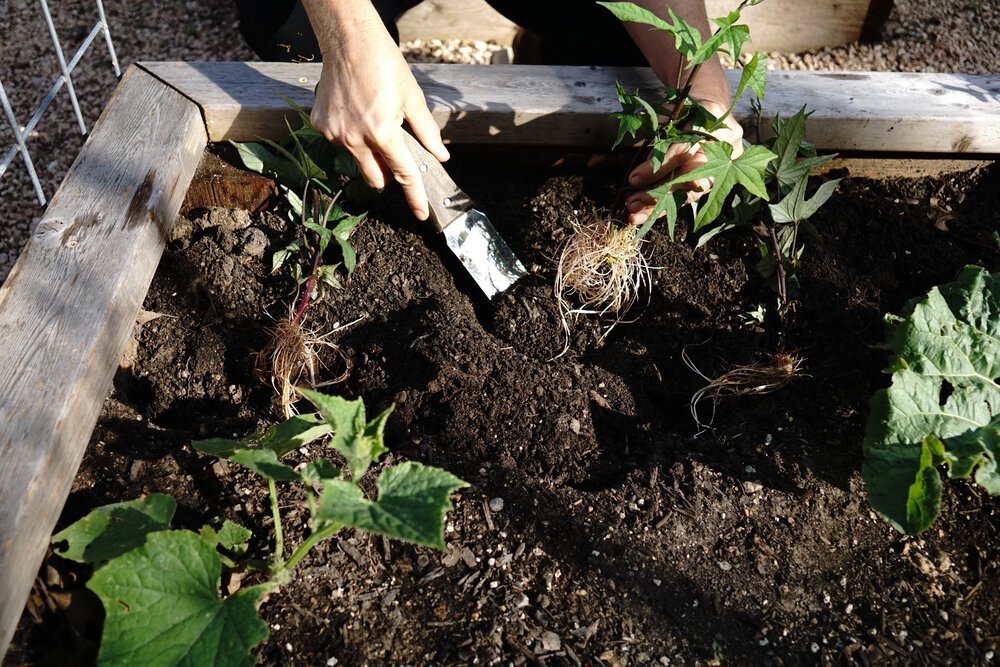Collard Greens - Plant them now and harvest for months to come
If you haven’t yet figured out that edible gardening in the fall and winter in Central Texas is all about leafy greens, then let me prove it one more time with a cole crop that will readily take on December’s icy frosts and then provide you with an abundance of nutrient-dense leaves all winter and spring. Collards can be planted throughout the fall and into spring, but allowing them to mature during the freezes of winter will improve the flavor of the leaves.
Mustard Greens provide visual interest and big flavor
With all of the nutritious varieties of ‘greens’ we can grow in fall and winter in Central Texas, it’s easy to skip over some of the lesser known varieties like mustard greens. However, these easy-to-grow greens with a flavorful punch are very fast growing, and one of the first fall greens that are ready to be harvested, and that in itself is a great reason to grow it. Mustard is also a beautiful plant with many different textures and colors to use in the garden or in containers.
Try a new crop this fall - Fava Beans
There are so many fantastic fall garden staples that shine just as brightly on the plate as in the garden. Broccoli, snap peas, kale, and all the leafy greens. I love them all, but I always encourage gardeners to try growing at least one new crop each season. Experimenting and trial and error is how we become better gardeners. If you want to try a new crop that is as good for the soil as it is to eat, let fava beans be your new fall crop.
Grow your own superfood
I don’t know when I began eating kale regularly, but I definitely didn’t grow up eating it. It was most likely while living in Portland, Oregon during the kale-crazed early 2000’s. One of my many roommates at the time probably cooked it with tofu for dinner and I liked it. I have to admit, I’ve always been a very conscientious eater and it probably helped that I didn’t start with an aversions to kale.
Improve your soil during summer
During summer in Central Texas, once the evening temps reach over 75 degrees, many of the fruit-bearing plants that we grow will stop producing fertile flowers and cease to produce fruit. While our hardworking farmers and farm workers continue to harvest and plant crops so that we can have food to eat, backyard gardeners can adopt the pace of nature and take a summer break.
Plant Corn for fall
Enjoying local corn now? Plant some in July for a fall harvest too.
You may already be enjoying homegrown or local, farm-grown corn. If you aren’t growing your own, hopefully you have been finding some fresh ears at the farmer’s markets and local farms. Locally grown corn is one of those crops that taste so much better fresh than from a far away farm.
Easy to Grow and cook, Okra
Okra, a plant native to Africa is the perfect summer crop for Central Texas vegetable gardens. It is drought and heat tolerant and while it can grow in milder climates with limited success, it loves the south’s hot temperatures. It is actually one of the most heat tolerant vegetable species in the world and tolerates heavy, clay soils and intermittent water. Many northern gardeners are envious of our okra-growing superpowers, and with it’s gorgeous hibiscus-like flowers blooming on 6’ stalks, it practically begs to be grown in a southern garden.
Gardening as a Practice
I began my journey as a gardener and yogi at the same time - 18 years ago in Portland, Oregon. In the following years of engaging regularly in both activities, I made some observations about how we as a society think differently about these activities, and I think it may help beginning gardeners to think of gardening more like a yoga practice than as a skill to master.
I have made a profession out of gardening - I started a small landscaping business in Portland in 2004 and just recently started an edible gardening business in Austin after almost four years of teaching sustainable gardening techniques at a nonprofit here. As a compliment to my hours of laboring outside, I regularly attend Vinyasa yoga classes, using the time to stretch my overworked muscles and quiet my anxious mind. Yoga, gardening and I have walked hand in hand for almost two decades.
Four Easy Ways to Attract Pollinators to Your Yard
Pollinators like bees and butterflies are integral to a healthy ecosystem and perform useful services in the home garden too. Pollination occurs when pollen from the anther of a male flower is deposited on the stigma of a female flower. This is how plants reproduce. Some plants are pollinated by wind or water but many plants require insects to provide this service. Many of the food crops we eat come from bee pollinated plants - in fact scientists say that one in every three bites of food we eat comes from a bee pollinated plant.
A Case for a Season of Rest in the Garden
‘Adopt the pace of nature: her secret is patience.’ — Ralph Waldo Emerson
In Central Texas, our summer high temperatures remain in the upper nineties for three to four months, and once the evening temps hit 75 degrees or warmer, many of our summer crops will stop producing fertile flowers and hence, cease to produce fruit. While our hardworking farmers and farm workers continue to harvest and plant crops so that we can have food to eat, I want to encourage backyard gardeners to take a rest from gardening. Here is my case for making the fourth season of gardening, the season of rest.
Growing Sweet Potatoes is Summer Fun for Everyone
By the time May rolls around in Central Texas’ edible gardens, most of the heat-loving crops have been planted and we are tending to watering, pest-control and harvesting many of those fruits and veggies that were planted in March and April. In May, there are a few crops that can still be planted from seed like okra, melons, and southern peas. Sweet potatoes can also be planted now and they love our hot summer weather. The best varieties for growing in Central Texas are Beauregard, Centennial, and Jewel. The method for planting and growing them is unique and the reward of a treasure hunt-like harvest can make a new gardener feel very accomplished.
Pruning and Staking Tomatoes for Optimal Plant Health and Productivity
Over the past couple of weeks, in response to the coronavirus pandemic, there has been a surge of interest in food gardening. Whether the intent of starting a garden is to sustain your own food supply or just to provide a peaceful, outdoor activity and respite from the news, I am here for it and the thought of Victory Gardens in American’s homes again has me feeling optimistic about at least one thing during these extremely difficult times. If you are one of the many people that recently purchased tomato starts for your garden, you can find information on varieties and planting methods in my previous article here (link). It would be unethical of me to provide you with that information and not carry you through to the best part - the harvest. Read on to find out how to care for those newly planted tomatoes to ensure a robust plant and plentiful harvest.
My Favorite Tomato Varieties, 2020
March in Central Texas means wildflowers, SXSW, Spring Break, and tomatoes. As soon as the temperatures start to warm up, all the garden centers are stocked with tomato transplants and all the gardeners are busy racing to get them in the ground. Now, last fall, some of you may have already scoured the seed catalogs for new tomato varieties and started your seeds indoors, but if you haven’t taken on indoor seed starting, don’t worry. As long as you get a healthy tomato start in the ground by March 15th, you could be tasting homegrown tomatoes straight off the vine in June.
Turnips, A cool season stunner
If you are familiar with the Central Texas Planting Guide, you know that February marks the end of the cool season gardening period of our year-long gardening calendar. Our sweat-free and bug-free gardening days are coming to a close, so let’s make the most of February in the garden shall we? Turnips are an often overlooked vegetable, so just as Michelle Obama took the opportunity in 2014 to champion them by co-opting a popular song which created a viral sensation, I’d like to show them some love this month too. You’ll have to add the pop music soundtrack though. Turnips are a member of the Brassica family - the large group of cruciferous vegetables like cabbage, broccoli, radish and kale. Turnips are typically grown for their root, but as with most brassicas, the leaves are edible too. Sold as Turnip Greens or Turnips Tops, the leaves are closely related to mustard greens and are most often braised before eaten. They are very high in Vitamin K as well as A, C and Folate.
Spinach is a Reliable, Healthful, Cold Weather Wonder
Spinach is a reliable winter staple in Central Texas edible gardens. It really is a gold medal worthy plant so if you aren’t already growing it, pick up some seeds and let’s get growing. One of my favorite things about spinach is that my kids absolutely love to eat it. Yes, they like their spinach salads to be doused in homemade ranch dressing (and I oblige!) but they will also eat it raw and plain or sauteed with olive oil and garlic. It is very mild yet the texture is more enjoyable to munch on than lettuce. Spinach also packs a more nutritious punch than lettuce. It is an excellent source of vitamins A, C and K as well as folate and a good source of magnesium, manganese, iron and vitamin B12. But before I sing the praises of eating spinach, let me tell you how easy it is to grow in Central Texas this time of year.
The Late Season Crop you Shouldn't Forget About
After the excitement of planting the cool season edible garden subsides, there is still a must-grow plant that is maintenance-free and can be tucked into small spaces in the garden. If you have not grown garlic in your fall garden before, now is the time. Typically, garlic is planted in mid-October, but here in Central Texas, we can plant it through early December when soil temperatures are still around 50 degrees. It may seem like an advanced crop to grow, but it is actually very easy. In fact, it’s a plant-it-and-forget-it crop, and the flavor of homegrown garlic far surpasses that of store-bought. Because it is a long-season crop, it won’t be harvested until next summer but the only thing you need to account for is patience and utilizing space in your garden bed for the next 7-8 months. And because cooking with your homegrown garlic and having seed stock for the following year, it is well worth it.
















